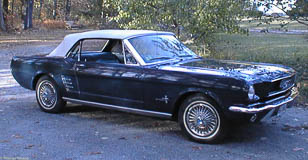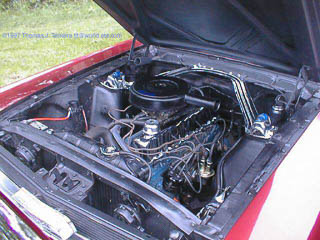6 Cylinder Classic Mustangs
Back in 1966, this is what many new Mustangs looked like. Nearly 5 out of 6 were hardtops or coupes. Moreover, a lot of them had the 200 cubic inch 6 cylinder engine. While Ford's official history says that 58% of the Mustangs
were V8's, it seems as though back then, everyone had straight six. At Mustang shows today, almost all the cars have V8's. But look at the Vehicle Identification Number (VIN) on the inner fender and you'll see that many of
these used to have six cylinders. People will look at our car and say "that's exactly like what I used to have." Some of them may not know the difference between a six and eight, but many do and proclaim that the engines last
forever. I don't know about that, though: the engine in my Dad's Mustang was replaced with a rebuilt engine at around 85,000 miles. Stop-and-go traffic may have taken its toll, but I don't think that engine was driven hard.
But that was also before all the quick oil-change shops hammered in the "every 3000 mile oil change" mantra.
Spotters Guide
On the left is a close-up of the wheel and front fender of the 6 cylinder Mustang. This has the standard stamped steel wheel cover for 1966. There's a running horse logo just behind the wheel well, but the fender between the headlamp
and wheel is empty. The Mustang on the right has a "V8 289" badge there indicating the engine type. In 1966, V8 Mustangs also had the running horse logo, but this car is a GT and has special GT badge instead. In later years,
the separate V8 badge was dropped but the engine size for V8's was part of the running horse logo.
Under the Hood
Of course the big difference between a V8 and straight six is under the hood. V8's have the distributor nestled between cylinder heads, spark plug wires neatly laid out to either side of the engine. There are lots of different
options for chrome air cleaners and a huge variety of valve covers. Okay, the chrome valve covers aren't any faster than the painted steel, but the cast aluminum ones might do a little bit to help cool the oil and the engine.
In comparison, the most striking thing initially about a six cylinder engine is how much room there is! You can just about climb into the engine compartment, particularly if there's no power steering or air conditioner. But most
of the owners of 6 cylinder Mustangs leave their "drivers" at home for the car show. As these pictures show, they shouldn't have to!
This is a very nicely restored, stock 6 cylinder engine which placed second at this car show(for 64? - 66 convertibles), just behind the 66 GT you can glimpse in the background. This was a rather unusual car since it has the fog
lights usually seen only on GT's or GT wannabees. But the engine compartment looks as good as any stock-detailed V8.
Anyway, at least one of these engines has the wrong color blue as well.
Just because Ford didn't sell chrome valve covers doesn't mean you can't add them. And why stop there? This 6 cylinder car has a chrome export brace and top shock mounts. I can only assume that the owner was still looking for a
place that would chrome plate the air cleaner.
The owner of this car decided to abandon the stock air cleaner for a chromed, open element air cleaner. Even the alternator is chrome plated. Makes the power steering pump look kinda lonely and blue.
This is another heavily chromed 6 cylinder engine, except the intake and exhaust manifolds are both natural cast iron instead of blue and silver painted.
Last and least, this 170 cubic inch 6 cylinder is actually in a 1964 Falcon, not a Mustang, although this engine was used in early 1965 Mustangs (often called 1964½ Mustangs).
It does seem to be true that most of the 6 cylinder Mustangs at shows have the Sprint package. You can see (or not see) where there's no trim in the rear quarter, and this one doesn't even have the C-stripe paint. It could
have been ordered this way, but it's more likely just a casualty of the repaint.














